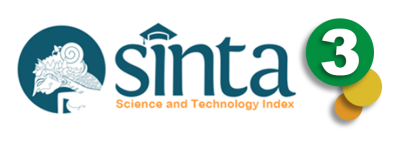ANALISIS KELAYAKAN USAHATANI PADI ORGANIK DAN KONVENSIONAL DI KECAMATAN MOJOGEDANG KABUPATEN KARANGANYAR
Abstract
Rice farming is the dominant farming business in Java, one of which is Central Java. Rice is still the primadonna commodity because the staple food of most Indonesian people is rice. Currently, there is starting to be a shift from previously conventional farming techniques to organic farming to maintain soil fertility and environmental safety. This research aims to analyze the income and feasibility of organic rice farming and conventional rice farming in Mojogedang District, Karanganyar Regency and was carried out in June-August 2023. This research was carried out using a quantitative approach and descriptive analysis. The research location was determined purposively in the Tani Mulyo 1 Group, Mojogedang District, Karanganyar Regency, involving 25 organic rice farmers and 25 conventional rice farmers. This research uses cost, revenue, income analysis, and also feasibility analysis using the R/C ratio and Break Event Point (BEP). The results of the analysis show that the total cost of organic rice farming is IDR. 9,960,600,- and costs for conventional rice farming are IDR. 10,117,375,-. Average revenue from organic farming is Rp. 47,094,000,- and the average revenue from conventional rice farming is Rp. 40,414,400. Based on these results, the difference between revenues and costs is known so that the income obtained in organic rice farming is Rp. 37,133,400,- and conventional rice farming income is Rp. 30,297,025,-. The R/C ratio value for organic rice farming is 4.73 and for conventional rice farming is 3.99. Based on this analysis, it can be concluded that organic rice farming and conventional rice farming are both feasible to run, but organic rice farming will provide a higher level of profit.
Downloads
References
Badan Pusat Statistik. (2022a). BPS-Statistics Indonesia.
Badan Pusat Statistik. (2022b). Direktori Usaha Pertanian Lainnya 2022.
Badan Pusat Statistik. (2022c). (THE RESULT OF CROP CUTTING SURVEY) ANALYSIS OF PADDY PRODUCTIVITY IN INDONESIA.
Databoks. (2022). ini-kontribusi-sektor-pertanian-terhadap-ekonomi-ri-tahun-2021.
Gufron, D. R., Inayah, T., & Junaidi, J. (2021). PERBANDINGAN PENDAPATAN USAHATANI PADI ORGANIK DAN PADI ANORGANIK DI DESA WATUKEBO, KECAMATAN BLIMBINGSARI KABUPATEN BANYUWANGI. Sharia Agribusiness Journal, 1(2). https://doi.org/10.15408/saj.v1i2.22282
Hasugian, J. K., Damayanti, Y., & Naiggolan, S. (2016). Analisis komparasi Usahatani padi organik dan non organik di kecamatan sarolangun kabupaten sarolangun. Sosio Ekonomika Bisnis, 19(2). https://doi.org/https://doi.org/10.22437/jiseb.v19i2.5024
Irfan, Nuraeni, & Salim, M. (2019). ANALISIS KOMPARASI USAHATANI PADI ORGANIK DAN USAHATANI PADI KONVENSIONAL. Wiratani, 2(2), 92–105. https://doi.org/https://doi.org/10.33096/wiratani.v2i2.38
Ken. (2018). metode ilmiah. tiga serangkai.
Muzdalifah, S., Awami, S. N., & Supardi, S. (2020). Analisis Komparatif Usahatani Padi (Oryza sativa L.) ANALISIS KOMPARATIF USAHATANI PADI (Oryza sativa L.) SISTEM BUDIDAYA SECARA ORGANIK DAN ANORGANIK DI KECAMATAN MIJEN KOTA SEMARANG. Jurnal Ilmiah Cendekia Eksakta, 5(1), 22–29. https://doi.org/http://dx.doi.org/10.3194/ce.v5i1.3317
Pribadi, O. O. (2021). ANALISIS KOMPARASI PENDAPATAH USAHATANI PADI SAWAH SRI ORGANIK DAN PADI SAWAH KONVESIONAL DI DESA KELAYANG KECAMATAN RAKIT KULIM KABUPATEN INDRAGIRI HULU [Skripsi]. Universitas Islam Riau.
Ristianingrum, A., Chozin, M. A., Machfud, M., Sugiyanta, S., & Mulatsih, S. (2016). Optimalisasi Keberlanjutan Pengembangan Usaha Padi Organik di Kabupaten Cianjur, Jawa Barat. Jurnal Manajemen Dan Agribisnis, 13(1), 37–49. https://doi.org/10.17358/jma.13.1.37
Sarwono. (2006). Metode Penelitian Kuantitatif dan Kualitatif. Graha Ilmu.
Soekartawi. (2006). Analisis Usahatani. UI Press.
Sutikno. (2020). ANALISA KOMPARATIF USAHA TANI PADI ORGANIK DAN PADI ANORGANIK (STUDI KASUS DI KELOMPOK TANI SUMBER JAYA DESA RAJEKWESI KECAMATAN KENDIT KABUPATEN SITUBONDO). AGRIBIOS : Jurnal Ilmiah, 18(1). https://doi.org/https://doi.org/10.36841/agribios.v18i1.887

This work is licensed under a Creative Commons Attribution 4.0 International License.





















